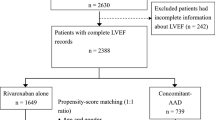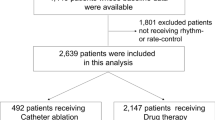Abstract
The acute management of recent-onset (<48 h) atrial fibrillation (AF) is still debated. Aim of our study was to compare efficacy and safety of intravenously administered class IC antidysrhythmic agents vs amiodarone in a propensity score matched series of patients acutely treated for AF in the emergency department. During a 3-year period, we retrospectively evaluated all episodes of recent-onset (<48 h) AF pharmacologically treated for sinus rhythm restoration in the emergency department. By means of a propensity score matching considering the main statistically different covariates, we selected two accurately matched treatment groups. We analysed the differences between amiodarone and class IC group in terms of efficacy and safety that is conversion to sinus rhythm rates within 12 and 48 h after starting treatment, time to conversion, and adverse drug effects. An overall number of 817 episodes of recent-onset AF were collected (amiodarone group = 406, class IC group = 411). After matching, we obtained 358 episodes equally divided (amiodarone group = 179 and class IC group = 179). Conversion rates within 12 h were 139 (53.1 %) in amiodarone group and 95 (72.6 %) in class IC group (p < 0.05). Median time for cardioversion was 420 min (331.6–508.3 CI 95 %) in amiodarone and 55 min (44.9–65.1 CI 95 %) in class IC group (p < 0.05). The incidence of adverse events in both groups was very low and equally distributed (p = ns). Intravenously administration of class IC agents, when compared with amiodarone, proved to be more rapid and effective, and equally safe in the acute management of recent-onset AF.

Similar content being viewed by others
References
Hamilton A et al (2015) The epidemiology and management of recent-onset atrial fibrillation and flutter presenting to the emergency department. Eur J Emerg Med 22(3):155–161
Patel NJ et al (2014) Contemporary trends of hospitalization for atrial fibrillation in the United States, 2000 through 2010: implications for healthcare planning. Circulation 129(23):2371–2379
Oishi ML, Xing S (2013) Atrial fibrillation: management strategies in the emergency department. Emerg Med Pract 15(2):1–26
Camm AJ et al (2012) 2012 focused update of the ESC Guidelines for the management of atrial fibrillation: an update of the 2010 ESC Guidelines for the management of atrial fibrillation—developed with the special contribution of the European Heart Rhythm Association. Europace 14(10):1385–1413
January CT (2014) 2014 AHA/ACC/HRS guideline for the management of patients with atrial fibrillation: a report of the American College of Cardiology/American Heart Association Task Force on Practice Guidelines and the Heart Rhythm Society. J Am Coll Cardiol 64(21):e1–e76
Stiell IG et al (2011) Variation in management of recent-onset atrial fibrillation and flutter among academic hospital emergency departments. Ann Emerg Med 57(1):13–21
Cristoni L et al (2011) Cardioversion of acute atrial fibrillation in the short observation unit: comparison of a protocol focused on electrical cardioversion with simple antiarrhythmic treatment. Emerg Med J 28(11):932–937
Rajagopalan B et al (2012) Contemporary approach to electrical and pharmacological cardioversion of atrial fibrillation. Postgrad Med 124(6):26–35
Rogenstein C et al (2012) An international view of how recent-onset atrial fibrillation is treated in the emergency department. Acad Emerg Med 19(11):1255–1260
Tamperi A et al (2012) Cardioversion in atrial fibrillation. Focus on recent-onset atrial fibrillation. Intern Emerg Med 7(Suppl 3):S241–S250
Slavik RS (2002) Intravenous amiodarone for acute pharmacological conversion of atrial fibrillation in the emergency department. CJEM 4(6):414–420
Stoschitzky K et al (2016) Propafenone shows class Ic and class II antiarrhythmic effects. Europace 18(4):568–571
Cohn BG et al (2013) Is emergency department cardioversion of recent-onset atrial fibrillation safe and effective? J Emerg Med 45(1):117–127
Von Besser K et al (2011) Is discharge to home after emergency department cardioversion safe for the treatment of recent-onset atrial fibrillation? Ann Emerg Med 58(6):517–520
Rosenbaum P, Rubin D (1983) The central role of the propensity score in observational studies for causal effects. Biometrika 70:14
Austin PC, Grootendorst P, Anderson GM (2007) A comparison of the ability of different propensity score models to balance measured variables between treated and untreated subjects: a Monte Carlo study. Stat Med 26:734–753
Crozier I et al (2003) Management of atrial fibrillation in the emergency department. Intern Med J 33(4):182–185
Wakai A, O’Neill JO (2003) Emergency management of atrial fibrillation. Postgrad Med J 79(932):313–319
Raghavan AV et al (2005) Management of atrial fibrillation in the emergency department. Emerg Med Clin North Am 23(4):1127–1139
Stiell IG et al (2011) Canadian Cardiovascular Society atrial fibrillation guidelines 2010: management of recent-onset atrial fibrillation and flutter in the emergency department. Can J Cardiol 27(1):38–46
Stiell IG et al (2010) Association of the Ottawa Aggressive Protocol with rapid discharge of emergency department patients with recent-onset atrial fibrillation or flutter. CJEM 12(3):181–191
Xavier Scheuermeyer F et al (2010) Thirty-day outcomes of emergency department patients undergoing electrical cardioversion for atrial fibrillation or flutter. Acad Emerg Med 17(4):408–415
McDonald AJ et al (2008) Increasing US emergency department visit rates and subsequent hospital admissions for atrial fibrillation from 1993 to 2004. Ann Emerg Med 51(1):58–65
Naccarelli GV et al (2003) A review of clinical trials assessing the efficacy and safety of newer antiarrhythmic drugs in atrial fibrillation. J Interv Card Electrophysiol 9(2):215–222
Rudo T, Kowey P (2006) Atrial fibrillation: choosing an antiarrhythmic drug. Curr Cardiol Rep 8:370–376
Krishnamoorthy S, Lip GY (2009) How safe is the antiarrhythmic drug therapy in atrial fibrillation? Europace 11:837–839
Cybulski J et al (2003) Intravenous amiodarone for cardioversion of recent-onset atrial fibrillation. Clin Cardiol 26(7):329–335
Khan IA et al (2003) Amiodarone for pharmacological cardioversion of recent-onset atrial fibrillation. Int J Cardiol 89(2–3):239–248
Vardas PE, Kochiadakis GE (2003) Amiodarone for restoration of sinus rhythm in patients with atrial fibrillation. Card Electrophysiol Rev 7(3):297–299
Nichol G et al (2002) Meta-analysis of randomized controlled trials of effectiveness of antiarrhythmic agents at promoting sinus rhythm in patients with atrial fibrillation. Heart 87(6):535–543
Chevalier P et al (2003) Amiodarone versus placebo and class 1c drugs for cardioversion of recent-onset atrial fibrillation: a meta-analysis. J Am Coll Cardiol 41(2):255–262
Gitt AK et al (2013) Types and outcomes of cardioversion in patients admitted to hospital for atrial fibrillation: results of the German RHYTHM-AF Study. Clin Res Cardiol 102(10):713–723
Lip GY et al (2007) Management of atrial fibrillation. Lancet 370:604–618
Cosio FG et al (2008) Delayed rhythm control of atrial fibrillation may be a cause of failure to prevent recurrences: reasons for change to active antiarrhythmic treatment at the time of the first detected episode. Europace 10(1):21–27
Martinez-Marcos FJ et al (2000) Comparison of intravenous flecainide, propafenone and amiodarone for conversion of acute atrial fibrillation to sinus rhythm. Am J Cardiol 86(9):950–953
Kochiadakis et al (2007) A comparative study of the efficacy and safety of procainamide versus propafenone versus amiodarone for the conversion of recent-onset atrial fibrillation. Am J Cardiol 99:1721–1725
Conti A et al (2010) Management of patients with acute atrial fibrillation in the ED. Am J Emerg Med 28(8):903–910
Author information
Authors and Affiliations
Corresponding author
Ethics declarations
Conflict of interest
The authors declare that they have no conflict of interest.
Statement of human and animal rights
All the patients' treatments and the data collection were obtained according to the last version of the Declaration of Helsinki.
Informed consent
All patients gave an informed consent regarding the treatment and the data collection which is stored in the medical record.
Rights and permissions
About this article
Cite this article
Bonora, A., Turcato, G., Franchi, E. et al. Efficacy and safety in pharmacological cardioversion of recent-onset atrial fibrillation: a propensity score matching to compare amiodarone vs class IC antiarrhythmic drugs. Intern Emerg Med 12, 853–859 (2017). https://doi.org/10.1007/s11739-016-1497-4
Received:
Accepted:
Published:
Issue Date:
DOI: https://doi.org/10.1007/s11739-016-1497-4




